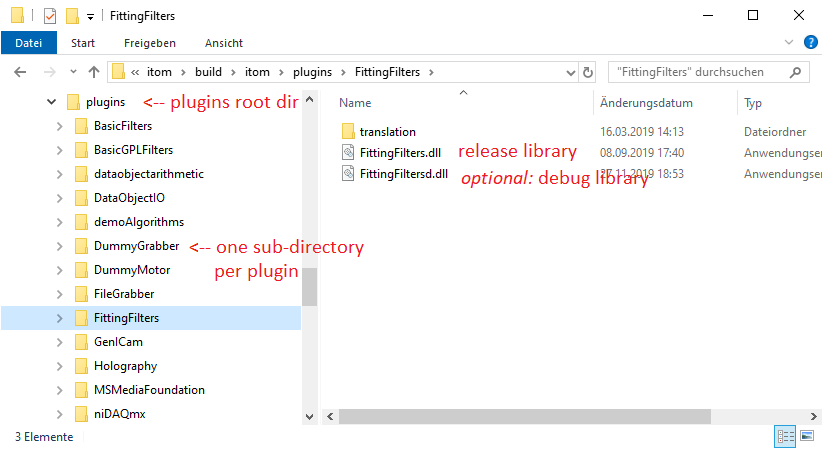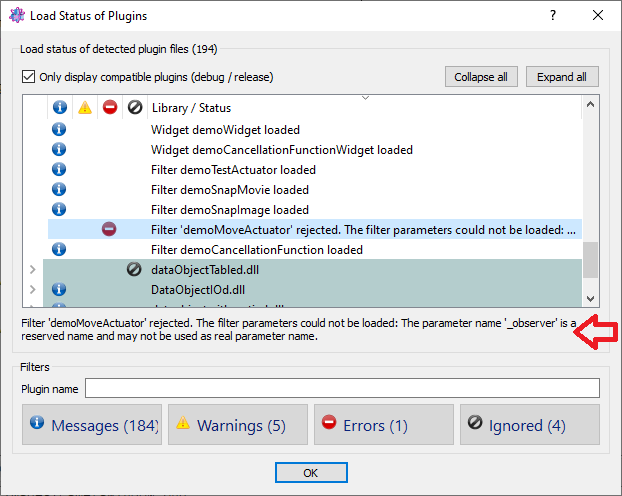7.2. Loading plugins¶
itom plugins are dynamically linked libraries (Windows: DLL files, Linux: SO files), based on the Qt plugin mechanism (see the plugin programming section of this documentation for more information).
At startup of itom, the subdirectory plugins of the itom root directory is recursively scanned for all available library files. Usually the folder structure of the plugins directory is like the following example (Windows):
Usually, each plugin project automatically creates a subfolder in the plugins base directory. This subfolder then contains optional translation, documentation or sample files as well as at least one library (DLL). Usually libraries with the file suffix d.dll correspond to debug built versions of the libraries and dll files without the suffix d are the release versions. Of course, the debug versions are usually not contained in default versions of itom.
When itom detects any kind of library in any subfolder of the plugins base directory, it is tested with respect to different rules, before it is accepted as itom plugin and loaded.
All plugins of itom can make use of commonly used libraries of itom, located in the SDK subfolder of the itom root directory. Plugins can only be successfully loaded by itom, if they where compiled with binary compatible versions of all common libraries (e.g. dataObject, commonLib, commonLibQt…) than the current version of itom. To ensure this, the major interface to all plugins, denoted as ito::AddInInterface, is eqipped with a version number, following the scheme of semantic versioning (semver.org). Hence, a core developer of itom has to increment the major version number of this interface (see file addInInterfaceVersion.h) if at least one of the commonly used libraries are changed in a binary-incompatible way. If methods are added to one of these libraries, the minor version number of the add-in interface has to be incremented…
At the startup of itom, the application recursively scans the plugins folder and looks for any DLL-file on Windows machines or so-file on a Linux operating system. Then each DLL is tried to be loaded using the plugin system provided by the Qt-framework. The DLL can successfully be loaded if the following prerequisites are fulfilled:
The plugin is a release version if itom is started in release mode OR
The plugin is a debug version (this can for example be seen if the DLL-name ends with …d.dll) if itom is started in debug mode
The plugin is compiled using the same major and minor version of Qt than itom (it is possible to load a plugin compiled with Qt 5.9.6 with itom compiled with 5.9.3)
The plugin is compiled with the same compiler and the same bitness level (x86/x64) than itom (e.g. MSVC 2015, x64)
If the plugin is dependent on other shared libraries which are not linked using a delay-load mechanism, the plugin can only be loaded if every necessary shared library can be found and successfully be loaded. If the dependency could not be loaded, the plugin-load fails with an error message module could not be loaded.
The remarks contained in the plugin with respect to a minimum and maximum version number of itom must correspond to the version number of your itom
The add-in interface number, that was used to compile a plugin, has to be compatible to the current add-in interface number of itom. The compatibility is given if the major part of the version number is equal and if the minor version number of the plugin is greater or equal than the minor number, contained in itom.
Finally, every successfully loaded plugin is included in the plugins toolbox of itom.
Note
The version number of the add-in interface has nothing to do with the version number of itom. This add-in interface version number is contained in the file common/addInInterfaceVersion.h and can also be seen in the property dialog of any plugin library (under Windows).
The load status of all plugins can be seen in the loaded plugins dialog of itom (menu file >> loaded plugins…):
In this dialog, you can see all detected libraries including their load status. Whenever a plugin could not be loaded, expand the major entry and click the subentry. Then you can read the full error message below the tree view.
Here is a list of common error messages in this dialog:
Could not load library ‘…’: Module could not be loaded: It is likely, that the plugin library depends on further 3rd party libraries, which could not be detected (in the itom root directory, in the subdirectory lib* or in any pathes, contained in the PATH environment variable of the operating system). Under Windows, it is recommended to use the dependency walker tool to check the dependencies of the corresponding plugin library.
AddIn ‘…’ fits to the obsolete interface 3.3.2. The AddIn interface of this version of ‘itom’ is 4.0.0.: This indicates that the plugin is compiled with an older version of the itom SDK. Please re-compile the plugin with the current version of the SDK.
AddIn ‘…’ fits to a new addIn-interface, which is not supported by this version of itom. The AddIn interface of this version of ‘itom’ is 4.0.0.: The plugin is likely to be compiled with a newer version of the itom SDK than used by this version of itom.
The plugin ‘…’ uses an incompatible Qt library: The plugin has been compiled with an incompatible version of Qt, also with respect to the release / debug match between itom and its plugins.
The file ‘…’ is not a valid Qt plugin.: This library is no Qt / itom plugin at all. Maybe it is a 3rd party library, used by any other plugin.
AddIn ‘…’ does not fit to the general interface AddInInterfaceBase: This library seems to be a Qt library, but does not implement the required interface of itom plugins (ito.AddIn.InterfaceBase/major-version-number).
Please consider, that the loaded plugins dialog also displays the load status of additional designer plugins (located in the subfolder designer of itom). These designer plugins contain plots or additional widgets, that can be included in user defined GUIs of itom. They follow another interface system. For more information see Plots and Figures or Custom Designer Widgets.

